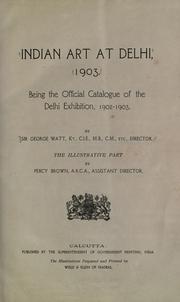Indian Art Exhibition Delhi

About
Summary
Exquisite
TOC
Details
Related
URL
Images
Overview
Indian Art at Delhi, 1903, also known as Being the Official Catalogue of the Delhi Exhibition, 1902-1903, was authored by Sir George Watt, with illustrations by Percy Brown. This catalog documents the Delhi Art Exhibition, marking the British government's final major expression of interest in Indian arts and crafts as imperial rulers. The government decided to publish the catalogue because it contained information of permanent value regarding Indian Arts and Industries.Indian Art at Delhi, 1903 serves as the official record of the Delhi Exhibition of 1902-1903, which showcased a wide array of Indian arts and crafts. The exhibition, and consequently the catalogue, was a manifestation of British interest in documenting and understanding the artistic traditions of India. The catalogue provides detailed descriptions of the exhibits, offering insights into the materials, techniques, and cultural significance of the various art forms on display.
Key Themes
Documentation of Indian Arts and Crafts: The primary theme is the comprehensive documentation of Indian artistic traditions, encompassing a wide range of materials, techniques, and styles.
Imperial Interest in Indian Art: The book reflects the British Empire's interest in understanding and classifying Indian art, driven by both genuine appreciation and colonial motives.
Cultural Exchange: The exhibition itself facilitated a degree of cultural exchange between British administrators, scholars, and Indian artisans, fostering dialogue and understanding.
Cultural Significance
Historical Record: The catalogue provides a valuable historical record of Indian art and craft traditions at the turn of the 20th century, offering insights into a period of significant social and political change.
Representation of Indian Art: The book contributed to shaping Western perceptions of Indian art, influencing collecting practices, and academic studies.
Effects on Society
Preservation of Cultural Heritage: By documenting and promoting Indian arts and crafts, the catalogue contributed to the preservation of cultural heritage, ensuring that these traditions were recognized and valued.
Influence on Art Education: The book may have influenced art education in India, as it provided a comprehensive overview of different artistic styles and techniques.
Promotion of Indian Art: The exhibition and its catalogue helped to promote Indian art to a wider audience, both in India and abroad, fostering appreciation and interest in these artistic traditions.
Conclusion
Indian Art at Delhi, 1903 remains a valuable resource for scholars, art historians, and anyone interested in learning more about the rich and diverse artistic traditions of India.
Table of Content
\"Indian Art Exhibition Delhi\" by Sir George Watt, published in 1903, documents and analyzes the art exhibited during the Indian Art Exhibition held in Delhi. Sir George Watt, a noted art historian and curator, provides a comprehensive overview of the artworks presented, along with detailed descriptions and critiques.Table of Contents - \"Indian Art Exhibition Delhi\" (1903 Edition)
PrefaceIntroduction to the purpose of the exhibition and the objectives of the book.
Acknowledgments and background information on the exhibition.
Chapter 1: Introduction to Indian ArtOverview of Indian art and its historical development.
Contextual background of Indian art traditions and styles.
Chapter 2: The Indian Art ExhibitionDescription of the organization and setup of the exhibition in Delhi.
Objectives of the exhibition and its significance in the context of Indian art.
Chapter 3: Sculptures and StatuesDetailed descriptions and analyses of sculptures and statues exhibited.
Insights into the materials, techniques, and styles used in the sculptures.
Chapter 4: Paintings and MiniaturesExamination of the paintings and miniature artworks displayed.
Discussion on artistic styles, themes, and historical context.
Chapter 5: Textiles and Decorative ArtsAnalysis of textiles, including fabrics, embroidery, and other decorative arts.
Description of techniques and patterns used in the textiles.
Chapter 6: Metalwork and JewelryOverview of metalwork and jewelry pieces featured in the exhibition.
Insights into craftsmanship, design, and cultural significance.
Chapter 7: Pottery and CeramicsReview of pottery and ceramic works exhibited.
Discussion on the artistic styles, manufacturing techniques, and historical background.
Chapter 8: Architectural Models and CraftsExamination of architectural models and various crafts showcased.
Analysis of design elements and their relevance to Indian architecture and craftsmanship.
Chapter 9: Regional Art StylesExploration of different regional styles and their representation in the exhibition.
Comparison of artistic traditions from various parts of India.
Chapter 10: Conclusion and ReflectionsSummary of the key findings and observations from the exhibition.
Reflections on the impact of the exhibition on the appreciation of Indian art.
Title
Indian Art Exhibition Delhi
Author
Sir George Watt
Name of Publisher
The Suprintendent of Govt Printing India
Publish Date
1903
Subject
The art exhibited during the Indian Art Exhibition held in Delhi
Vintage
1901-1947
Category
India
Sub Category
Economics
Rarity
RARE
